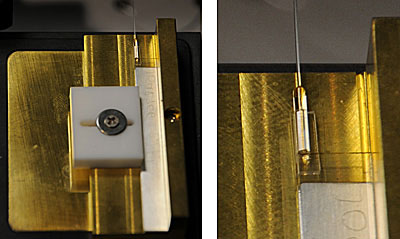| Aug 08, 2012 |
New device could improve fiber-optic quantum data transmission
|
|
(Nanowerk News) Tests performed at the National Institute of Standards and Technology (NIST) show that a new method for splitting photon beams could overcome a fundamental physical hurdle in transmitting electronic data. These results could lead to commercial systems that can help safeguard the transfer of sensitive information ("Dual-channel, single photon upconversion detector at 1.3 µm").
|
 |
| Nearly transparent, this lithium niobate crystal (visible just above the white square section at bottom right of righthand photo) is capable of splitting a beam of photons into two beams of two different colors, an innovation that may help send quantum information through fiber optic cables, one of which is attached to the crystal at its top left corner and extends straight upward to the top of the photo frame. (Image: Talbott/NIST)
|
|
The findings confirm that a prototype device developed with collaborators at Stanford University can double the amount of quantum information that can be sent readily through fiber-optic cables, and in theory could lead to an even greater increase in the rate of this type of transmission.
|
|
Conventional fiber-optic systems, in use for decades, transmit data as a series of light pulses—just a step up from Morse code. Such pulse streams can be intercepted by third parties undetectably. But the photons themselves can carry data, encoded in their quantum states. Because any attempt to intercept that data alters the quantum state, eavesdroppers can always be detected.
|
|
While information scientists have found a way to encode photon quantum states successfully, practical systems need the photons to be at wavelengths compatible with both existing optical-fiber networks and single-photon sensitive (and economically viable) silicon detectors. Unfortunately, these wavelengths are different.
|
|
One potential solution is to change the photons' wavelength from the infrared—desirable for fiber networks—to the visible spectrum so a silicon detector can "see" them. A method of doing so is to mix the information-carrying photons with a second photon beam. The information-carrying photons absorb this second beam's additional energy and get kicked up from the infrared region of the spectrum to the wavelength of visible red light, which silicon sensors can detect. However, silicon single-photon detectors cannot operate very fast, which puts limitations on data rates and ultimately, their usefulness for quantum information transmission systems.
|
|
"The limiting factor up until this point has been the detector speed," says Paulina Kuo, a scientist with NIST's Applied and Computational Mathematics Division. "Researchers would like a way around this issue, as it stands in the way of quantum information-based security innovations."
|
|
The heart of the newly developed device is a new crystal that goes beyond converting the wavelength of the photons. Designed and fabricated by Stanford's Jason Pelc, the crystal is capable of splitting the beam of infrared, information-carrying photons into two distinct beams of slightly different color, and directing the different-colored photons to different outputs. Controlling the flow to either output allows the team to use two "slow" detectors in place of one, thereby doubling the overall system speed.
|
|
NIST tests showed that this innovation allows twice as much data to be sent in a single beam, and Kuo says that the photons conceivably can be split not just into two, but several different beams.
|
|
"We first demonstrated this concept last year ("Up-conversion single-photon detector using multi-wavelength sampling techniques"), but with this new device, the technique can be scaled up, meaning that in theory, we can significantly increase the amount of information that can be sent," she says. "We hope this is a potential solution to the detector problem."
|

